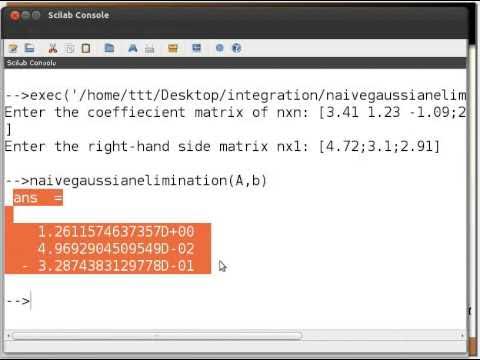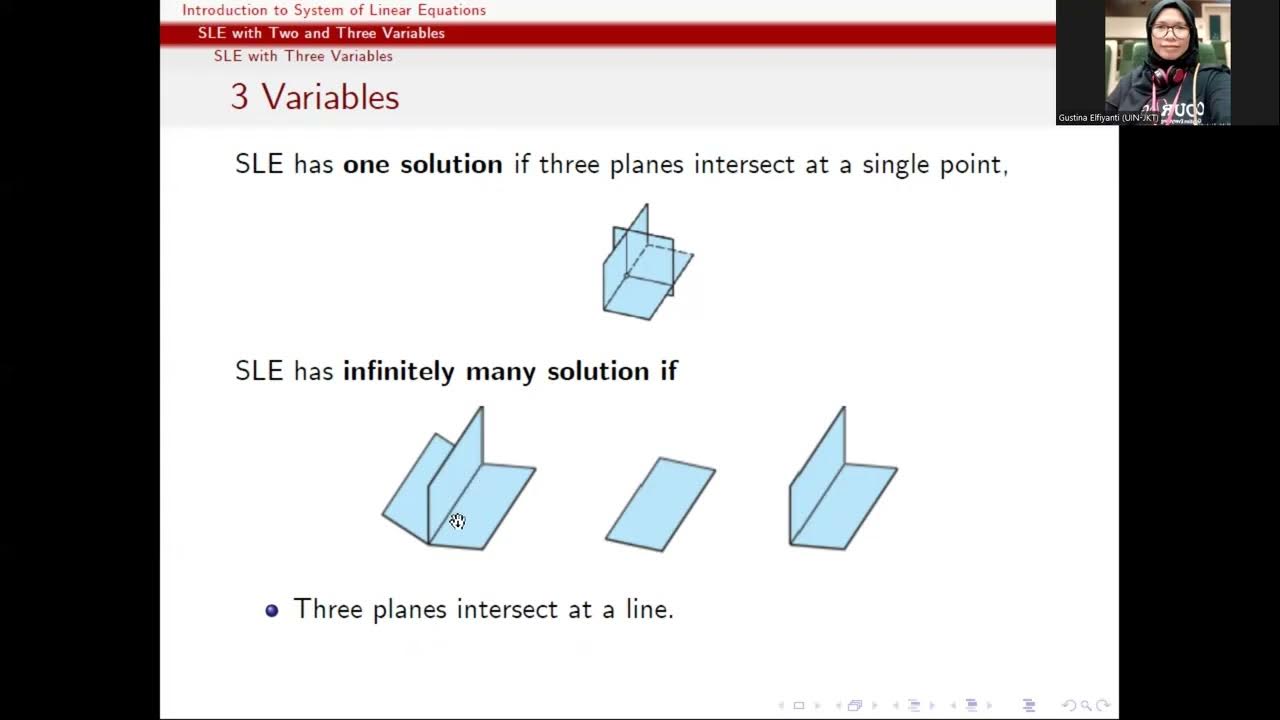METODE NUMERIK P2 | METODE GAUSS UNTUK MENYELESAIKAN SPL
Summary
TLDRIn this second session of the Numerical Methods course, the lecturer Fitria Zona Kumala introduces the topic of solving simultaneous linear equations using the Gauss elimination method. The session explores the concept of linear systems and the transformation of their matrices into an upper triangular form to simplify solving. Through an example, the Gauss elimination process is demonstrated step-by-step, emphasizing row operations and back substitution. The final solution to the system of equations is presented as x1 = 1, x2 = 2, and x3 = 3, illustrating the practical application of the method.
Takeaways
- 😀 A system of linear equations (SPL) involves multiple equations with variables, expressed in matrix form as A * X = B.
- 😀 The Gaussian elimination method transforms a system of linear equations into an upper triangular matrix with zero coefficients below the diagonal.
- 😀 The matrix A contains the coefficients of the variables, while matrix X contains the variables, and matrix B contains the constants from the system.
- 😀 Systems of linear equations can be either homogeneous (B = 0) or non-homogeneous (B ≠ 0), with different solution characteristics.
- 😀 A system of linear equations will have a unique solution if the rank of matrix A is equal to the number of variables (n).
- 😀 The Gaussian elimination method involves row operations, such as swapping rows, adding/subtracting multiples of rows, and multiplying rows by non-zero constants.
- 😀 To solve a system using Gaussian elimination, first write the system as an augmented matrix and then apply row operations to achieve an upper triangular form.
- 😀 Back-substitution is used to solve for the variables once the system is in upper triangular form, starting from the last row.
- 😀 An example of solving a system using Gaussian elimination involves working with a 3x3 matrix, performing row operations, and back-substituting to find values for variables.
- 😀 After row operations, the system of equations may be reduced to a simple form where solutions for each variable are obtained sequentially.
- 😀 The final solution of a system of linear equations is represented as a matrix containing the values of the variables that satisfy all the original equations.
Q & A
What is the main focus of this lesson in numerical methods?
-The main focus of this lesson is to study the solution of simultaneous linear equations, specifically using the Gaussian Elimination method to solve systems of linear equations.
What is a linear system of equations (SPL)?
-A linear system of equations, or SPL (Sistem Persamaan Linier), is a set of equations with multiple variables, where the relationship between the variables is linear. It can be expressed in the form Ax = B, where A is a matrix of coefficients, x is a column matrix of variables, and B is a column matrix of constants.
What is the difference between homogeneous and non-homogeneous systems of linear equations?
-A homogeneous system of linear equations is when the constants on the right-hand side of the equations (matrix B) are all zero. A non-homogeneous system has at least one non-zero constant in matrix B.
What does the rank of the augmented matrix indicate about the solution to a system of linear equations?
-The rank of the augmented matrix can help determine the number of solutions to the system. If the rank equals the number of variables, the system has a unique solution. If the rank is less than the number of variables, the system has infinitely many solutions, or no solution if the rank of the matrix and the augmented matrix are different.
What is the Gaussian Elimination method used for?
-The Gaussian Elimination method is used to solve systems of linear equations by transforming the system's augmented matrix into an upper triangular form, allowing for easy back-substitution to find the solutions.
How does the Gaussian Elimination method transform a matrix?
-The method transforms a matrix into an upper triangular form by using elementary row operations: swapping rows, multiplying a row by a non-zero constant, and adding or subtracting multiples of one row to another.
What are the elementary row operations used in Gaussian Elimination?
-The three elementary row operations used in Gaussian Elimination are: 1) swapping two rows, 2) multiplying a row by a non-zero constant, and 3) adding or subtracting a multiple of one row to another row.
What is the first step in applying Gaussian Elimination to a system of equations?
-The first step is to set up the augmented matrix of the system, where the coefficients of the variables are placed in a matrix and the constants are placed in a separate column.
How does one achieve zeroes below the main diagonal in Gaussian Elimination?
-To achieve zeroes below the main diagonal, you perform row operations such as subtracting appropriate multiples of the first row from the rows below it to eliminate the elements below the pivot in the first column.
How do you perform back-substitution once the matrix is in upper triangular form?
-Once the matrix is in upper triangular form, you start with the last row, which contains only one variable, and solve for it. Then, substitute that value into the previous rows to solve for the other variables.
Outlines

Cette section est réservée aux utilisateurs payants. Améliorez votre compte pour accéder à cette section.
Améliorer maintenantMindmap

Cette section est réservée aux utilisateurs payants. Améliorez votre compte pour accéder à cette section.
Améliorer maintenantKeywords

Cette section est réservée aux utilisateurs payants. Améliorez votre compte pour accéder à cette section.
Améliorer maintenantHighlights

Cette section est réservée aux utilisateurs payants. Améliorez votre compte pour accéder à cette section.
Améliorer maintenantTranscripts

Cette section est réservée aux utilisateurs payants. Améliorez votre compte pour accéder à cette section.
Améliorer maintenantVoir Plus de Vidéos Connexes
5.0 / 5 (0 votes)






